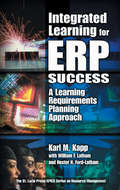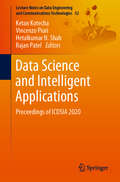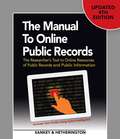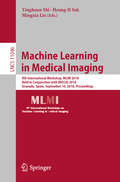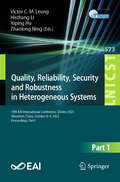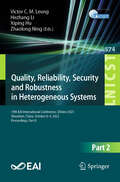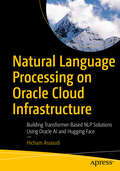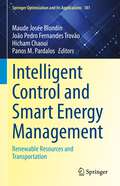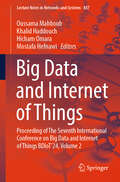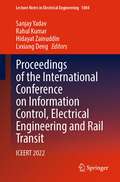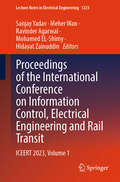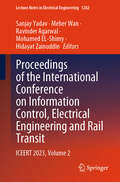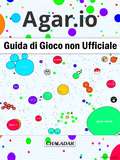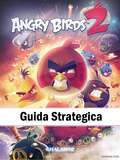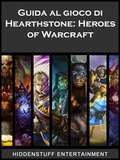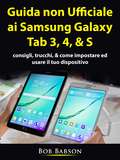- Table View
- List View
Integrated Learning for ERP Success: A Learning Requirements Planning Approach (Resource Management)
by Karl M. Kapp William F. Latham Hester Ford-LathamThe results are in. The evidence has been analyzed. Research shows that the lack of enterprise-wide training is the biggest reason for ERP implementation failures. It is the single most important precursor to achieving success. Integrated Learning for ERP Success is the first resource to offer a specifically defined, comprehensive method fo
Data Science and Intelligent Applications: Proceedings of ICDSIA 2020 (Lecture Notes on Data Engineering and Communications Technologies #52)
by Vincenzo Piuri Ketan Kotecha Hetalkumar N. Shah Rajan PatelThis book includes selected papers from the International Conference on Data Science and Intelligent Applications (ICDSIA 2020), hosted by Gandhinagar Institute of Technology (GIT), Gujarat, India, on January 24–25, 2020. The proceedings present original and high-quality contributions on theory and practice concerning emerging technologies in the areas of data science and intelligent applications. The conference provides a forum for researchers from academia and industry to present and share their ideas, views and results, while also helping them approach the challenges of technological advancements from different viewpoints. The contributions cover a broad range of topics, including: collective intelligence, intelligent systems, IoT, fuzzy systems, Bayesian networks, ant colony optimization, data privacy and security, data mining, data warehousing, big data analytics, cloud computing, natural language processing, swarm intelligence, speech processing, machine learning and deep learning, and intelligent applications and systems. Helping strengthen the links between academia and industry, the book offers a valuable resource for instructors, students, industry practitioners, engineers, managers, researchers, and scientists alike.
The Manual to Online Public Records: The Researcher's Tool to Online Resources of Public Records and Public Information
by Hetherington Sankey<p>In the 4th edition of The Manual to Online Public Records, authors Sankey and Hetherington shed new light on the mystique of finding public records from government and private sources. The What, Where, and How of online public record access is contained herein on a nationwide basis. <p>Two words epitomize the benefits readers will gain from this completely revised 4th edition: efficiency and accuracy. <p>New chapters explore how to analyze record searching methodology and how to best use social media sites for advanced, creative techniques of finding electronic and paper trails of records. <p>An analysis of 15,000+ government sites is arranged in individual state chapters. Data is presented in a format that is easy-to-use and practical in wording as well as spiked with subjective comments on value and benefits. Readers will soon learn of detailed information on key locations, including data not found from a Google Search. <p>The Manual also provides techniques on how to narrow the overwhelming array of vendors to find those sites that best suit a researcher's needs. <p>More than any of the earlier editions, this resource provides the competitive edge for concise record research.</p>
Machine Learning in Medical Imaging: 9th International Workshop, MLMI 2018, Held in Conjunction with MICCAI 2018, Granada, Spain, September 16, 2018, Proceedings (Lecture Notes in Computer Science #11046)
by Yinghuan Shi Heung-Il Suk Mingxia LiuThis book constitutes the proceedings of the 9th International Workshop on Machine Learning in Medical Imaging, MLMI 2018, held in conjunction with MICCAI 2018 in Granada, Spain, in September 2018.The 45 papers presented in this volume were carefully reviewed and selected from 82 submissions. They focus on major trends and challenges in the area of machine learning in medical imaging and aim to identify new cutting-edge techniques and their use in medical imaging.
Quality, Reliability, Security and Robustness in Heterogeneous Systems: 19th EAI International Conference, QShine 2023, Shenzhen, China, October 8 – 9, 2023, Proceedings, Part I (Lecture Notes of the Institute for Computer Sciences, Social Informatics and Telecommunications Engineering #573)
by Victor C. M. Leung Xiping Hu Zhaolong Ning Hezhang LiThis book constitutes the refereed post-conference proceedings of the 19th EAI International Conference on Quality, Reliability, Security and Robustness in Heterogeneous Networks, QShine 2023, held in October 2023. The 78 full papers included in these proceedings were carefully reviewed and selected from 200 submissions. They are organized in these topical sections: Part I: E-Health networks; transportation networks; reliability and scalability; E-Health networks II; artificial intelligence and machine learning I; networks and applications. Part II: Robustness; Network Security and Privacy; Quality of Service (QoS) and Quality of Experience (QoE); Artificial Intelligence and Machine Learning II; Autonomous Vehicles.
Quality, Reliability, Security and Robustness in Heterogeneous Systems: 19th EAI International Conference, QShine 2023, Shenzhen, China, October 8 – 9, 2023, Proceedings, Part II (Lecture Notes of the Institute for Computer Sciences, Social Informatics and Telecommunications Engineering #574)
by Victor C. M. Leung Xiping Hu Zhaolong Ning Hezhang LiThis book constitutes the refereed post-conference proceedings of the 19th EAI International Conference on Quality, Reliability, Security and Robustness in Heterogeneous Networks, QShine 2023, held in October 2023. The 78 full papers included in these proceedings were carefully reviewed and selected from 200 submissions. They are organized in these topical sections: Part I: E-Health networks; transportation networks; reliability and scalability; E-Health networks II; artificial intelligence and machine learning I; networks and applications. Part II: Robustness; Network Security and Privacy; Quality of Service (QoS) and Quality of Experience (QoE); Artificial Intelligence and Machine Learning II; Autonomous Vehicles.
Natural Language Processing on Oracle Cloud Infrastructure: Building Transformer-Based NLP Solutions Using Oracle AI and Hugging Face
by Hicham AssoudiThis book demonstrates how to use Oracle Cloud Infrastructure (OCI) and Hugging Face technologies to develop advanced NLP solutions. Through a practical case study, it addresses common NLP challenges and offers strategies for creating efficient, cost-effective transformer-based models. By the end of this book, you will have the skills and knowledge to create cutting-edge NLP solutions on OCI, customized to meet the needs of various industries and projects. The book takes you through the complete NLP solution life cycle—covering data preparation, model fine-tuning, deployment, and monitoring—while highlighting key topics such as cost-effectiveness and responsible AI for NLP implementations. Drawing from real-world experience and offering practical insights, it bridges the gap between theory and practice, equipping you to design and deploy scalable, cost-efficient NLP solutions. What You Will Learn Master key NLP concepts and the OCI ecosystem Create high-quality datasets using Hugging Face and OCI Data Labeling Service Fine-tune domain-specific pre-trained models from Hugging Face using OCI Data Science Notebook Sessions Deploy and operationalize your models with OCI Data Science Model Deployments Automate the NLP life cycle with OCI Data Science Pipelines Implement cost-effective strategies throughout the entire NLP life cycle, from dataset preparation to model training and deployment Who This Book Is For A diverse audience interested in implementing NLP solutions on Oracle Cloud Infrastructure: NLP practitioners, data scientists, and machine learning engineers who want to learn how to leverage Oracle AI and Hugging Face to implement an end-to-end NLP solution life cycle, from data preparation to model deployment; Oracle practitioners who want to expand their Oracle expertise by exploring OCI's advanced capabilities for building and scaling cutting-edge NLP solutions in enterprise environments; business decision makers who want to discover the strategic benefits of NLP solutions on OCI, including cost-effectiveness and responsible AI, while driving business value
Intelligent Control and Smart Energy Management: Renewable Resources and Transportation (Springer Optimization and Its Applications #181)
by Panos M. Pardalos Maude Josée Blondin João Pedro Fernandes Trovão Hicham ChaouiThis volume aims to provide a state-of-the-art and the latest advancements in the field of intelligent control and smart energy management. Techniques, combined with technological advances, have enabled the deployment of new operating systems in many engineering applications, especially in the domain of transport and renewable resources. The control and energy management of transportation and renewable resources are shifting towards autonomous reasoning, learning, planning and operating. As a result, these techniques, also referred to as autonomous control and energy management, will become practically ubiquitous soon. The discussions include methods, based on neural control (and others) as well as distributed and intelligent optimization. While the theoretical concepts are detailed and explained, the techniques presented are tailored to transport and renewable resources applications, such as smart grids and automated vehicles. The reader will grasp the most important theoretical concepts as well as to fathom the challenges and needs related to timely practical applications. Additional content includes research perspectives and future direction as well as insight into the devising of techniques that will meet tomorrow’s scientific needs. This contributed volume is for researchers, graduate students, engineers and practitioners in the domains of control, energy, and transportation.
Big Data and Internet of Things: Proceeding of The Seventh International Conference on Big Data and Internet of Things BDIoT'24, Volume 2 (Lecture Notes in Networks and Systems #887)
by Oussama Mahboub Khalid Haddouch Hicham Omara Mostafa Hefnawi"Big Data and Internet of Things" is the latest volume in the renowned Lecture Notes in Networks and Systems series. This book compiles the latest research presented at the Seventh International Conference on Big Data and Internet of Things (BDIoT'24), showcasing innovative solutions, emerging trends, and practical applications in the fields of big data and IoT. An essential read for researchers, professionals, and students looking to stay ahead in the rapidly evolving world of technology. The series contains proceedings and edited volumes in systems and networks, spanning the areas of Cyber-Physical Systems, Autonomous Systems, Sensor Networks, Control Systems, Energy Systems, Automotive Systems. Biological Systems, Vehicular Networking and Connected Vehicles, Aerospace Systems Automation, Manufacturing, Smart Grids. Nonlinear Systems, Power Systems, Robotics, Social Systems, Economic Systems and other. The series covers the theory, applications, and perspectives on the state of the art and future developments relevant to systems and networks, decision making, control, complex processes and related areas, as embedded in the fields of interdisciplinary and applied sciences, engineering, computer science, physics, economics, social, and life sciences, as well as the paradigms and methodologies behind them.
Proceedings of the International Conference on Information Control, Electrical Engineering and Rail Transit: ICEERT 2022 (Lecture Notes in Electrical Engineering #1084)
by Rahul Kumar Sanjay Yadav Hidayat Zainuddin Lvxiang DengThis book includes the peer-reviewed proceedings of the 2nd International Conference on Information Control, Electrical Engineering, and Rail Transit (ICEERT 2022). This book provides the advanced research results of transportation and covers the main research fields of information control, traffic information engineering, and control, intelligent transit, logistics, etc. This book aims to promote a new green and intelligent mode of rail transit between scholars from the top universities, research centers, and high-tech enterprises around the world, which is beneficial to researchers and practitioners in mechanical engineering.
Proceedings of the International Conference on Information Control, Electrical Engineering and Rail Transit: ICEERT 2023, Volume 1 (Lecture Notes in Electrical Engineering #1223)
by Sanjay Yadav Meher Wan Hidayat Zainuddin Ravinder Agarwal Mohamed El-ShimyThis book includes the peer-reviewed proceedings of the 3rd International Conference on Information Control, Electrical Engineering, and Rail Transit (ICEERT 2023). This book provides the advanced research results of transportation and covers the main research fields of information control, traffic information engineering, and control, intelligent transit, logistics, etc. This book aims to promote a new green and intelligent mode of rail transit between scholars from the top universities, research centers, and high-tech enterprises around the world, which is beneficial to researchers and practitioners in mechanical engineering.
Proceedings of the International Conference on Information Control, Electrical Engineering and Rail Transit: ICEERT 2023, Volume 2 (Lecture Notes in Electrical Engineering #1282)
by Sanjay Yadav Meher Wan Hidayat Zainuddin Ravinder Agarwal Mohamed El-ShimyThis book includes the peer-reviewed proceedings of the 3rd International Conference on Information Control, Electrical Engineering, and Rail Transit (ICEERT 2023). This book provides the advanced research results of transportation and covers the main research fields of information control, traffic information engineering, and control, intelligent transit, logistics, etc. This book aims to promote a new green and intelligent mode of rail transit between scholars from the top universities, research centers, and high-tech enterprises around the world, which is beneficial to researchers and practitioners in mechanical engineering.
Pokemon As Piadas e Memes Mais Hilários: As Piadas e Memes Mais Engraçados
by HiddenStuff EntretenimentoVocê está prestes a descobrir as piadas de Pokemon mais engraçadas de sempre. Este livro está preenchido com algumas das piadas mais engraçadas de pokemon. Descubra os temas mais populares, além de ridículos e bobos, das corporações Pokemon e simplesmente planeje piadas e memes hilários sobre eles! Baixe sua cópia imediatamente! Compre hoje e descubra todas das piadas mais populares de Pokemon!
Agar.io Guida di Gioco non Ufficiale
by Valeria Ciccotti Hiddenstuff Entertainment* GUIDA NON UFFICIALE * Suggerimenti avanzati e guida strategica. La più completa e unica dettagliata guida che troverai online. Disponibile per download immediato sul tuo smartphone, sul lettore di ebook o in forma cartacea. In seguito al successo delle centinaia di guide e delle strategie che ho scritto arriva un'altra guida avanzata professionale per giocatori nuovi e veterani. Questa guida offre strategie specifiche e suggerimenti per progredire nel gioco, sconfiggere gli avversari, guadagnare più monete e molto altro! - Suggerimenti e strategie professionali - Trucchi e hack - Segreti, consigli, trucchi, sbloccabili e stratagemmi usati da giocatori professionisti! - Metodi per ottenere un mare di monete - E in più molto altro! Tutte le versioni di questa guida contengono immagini per aiutarti a capire meglio il gioco. Non c'è nessun'altra guida completa e avanzata come questa. Disclaimer: questo prodotto non è associato, affiliato, sostenuto, certificato o sponsorizzato dal detentore dei diritti del gioco.
Angry Birds 2 Guida Strategica
by Hiddenstuff Entertainment Vanessa NicoliniSperiamo che troverete questa guida utile e vantaggiosa nella vostra missione all'immortalità digitale. Vorremo munire i giocatori di conoscenza e formare le loro abilità in modo da permettere di raggiungere i livelli più alti nei loro giochi. Questo a sua volta contribuisce ad un'esperienza positiva e più divertente.Dopo tutto, è nostra convinzione che le cose nella vita vadano godute il più possibile.
Battute, Meme, Immagini & Storie Divertenti sui Pokemon
by Hiddenstuff EntertainmentOttieni un accesso istantaneo alle battute più divertenti sui Pokemon! Scoprirai le battute più divertenti di sempre sui Pokemon. Questo libro è pieno con alcune delle battute più divertenti del mondo sui Pokemon. Scopri i personaggi più popolari dei Pokemon con battute e meme stupidi, ridicoli e semplicemente che fanno morire dal ridere su di loro! Scarica ora la tua copia! Purchase today and discover all of the most popular jokes for mario bros!
Farmville 2 Country Escape Guida di Gioco non Ufficiale
by Valeria Ciccotti Hiddenstuff EntertainmentCon la mia guida di gioco non ufficiale di Farmville 2 imparerete esattamente tutto ciò che dovete sapere per diventare giocatori esperti, ottenere monete e contanti illimitati, e risorse illimitate! La guida tratta i seguenti argomenti: - Panoramica e informazioni di base. - Come giocare. - Risorse per le missioni. - Giocare con gli amici in modo efficace. - Come crescere le colture 2 volte più velocemente! - Creare la fattoria perfetta. - Come ottenere un sacco di denaro e banconote. - Come ottenere risorse illimitate. - Come avere gli animali premio. - Panoramica delle ricompense. - Segreti, suggerimenti e trucchi usati dai giocatori professionisti! - Istruzioni dettagliate passo dopo passo! - E MOLTO ALTRO! Acquistate adesso e non rimarrete più bloccati, senza monete e senza risorse! Diventate oggi giocatori di alto livello! Disclaimer: Questo prodotto non è associato, affiliato, sostenuto o sponsorizzato da Zynga Inc., e non sono stati effettuati test, recensioni o certificazioni. Questa guida va usata come riferimento. Questo prodotto non modifica il gioco in alcun modo. Questa è una guida scritta e non è un programma software. Keywords: Farmville 2,game,guide,cheats,hacks,app,download,game,free,play,online,zynga,quests,xp,exchange,recipes,tips,yogurt,unlimited,water
Farmville 2 Country Escape Guía de Juego
by Hiddenstuff Entertainment Valeria Lissbeth Aguirre S.Este libro en línea contiene descripciones y pasos de cómo jugar Farmville 2. Contiene conceptos básicos, desde cómo ganar monedas y cómo subir de nivel rápidamente, a cómo cuidar el ganado y los cultivos de una manera más sencilla. FarmVille 2 es gratuito de Facebook y para múltiples jugadores, además, se caracteriza por tener llamativos escenarios y personajes en 3D. El jugador puede crear una granja personalizada donde los cultivos puedan crecer y también se pueda alimentar a los animales; estos son recursos de varios cultivos que apoyan las actividades agrícolas.
Geometry Dash Meltdown Guida Non Ufficiale del Gioco
by Stefania Pezzato Hiddenstuff EntertainmentOltre ad comprare questo libro iscriviti per il nostro programma di guide supplementari gratuite. Copiando il link qui sotto avrai accesso agli ultimi aggiornamenti per i più popolari videogiochi e app. Iscriviti gratis qua sotto: http://emailsignupform.subscribemenow.com/ Guida con Suggerimenti & Strategie Avanzati. Questa è la guida più completa e la sola dettagliata che troverai online. Disponibile per il download immediato sul tuo smartphone, eBook reader o in cartaceo. Con il successo delle mie altre centinaia di guide e strategie scritte, ho creato un'altra guida professionale avanzata per i giocatori nuovi e veterani. Questa guida fornisce specifiche strategie e suggerimenti sul come progredire nel gioco, battere i tuoi avversari, ottenere più monete e denaro, e molto altro! Ecco cosa avrai comprando questa guida del gioco professionale avanzata e dettagliata. - Suggerimenti e Strategie Professionali. - Cheat e Hack. - Segreti, Suggerimenti, Cheat, Sbloccabili, e Triucchi Usati dai Giocatori Pro! - Come Avere Tonnellate di Denaro/Monete. - E MOLTO ALTRO! Tutte le versioni di questa guida hanno degli screenshot per aiutarti a capire meglio il gioco. Non c'è altra guida completa e avanzata quanto questa. Se stai cercando guide su altri giochi e app famosi cerca altri titoli di Joshua J Abbott o della HSE Games. Sarai felici di aver comprato questa guida e ne trarrai molti benefici in confronto ad altre guide meno efficaci sul mercato. Comprala ora e batti i tuoi avversari! Diventa un Giocatore Pro Oggi! Per supporto e altre informazioni sui nostri prodotti visitate: http://www.hiddenstuffentertainment.com/ Disclaimer: Questo prodotto non è associato, affiliato, promosso o sponsorizzato dal Proprietario Originale del Copyright. Tutti i marchi che appaiono in questo ebook sono registrati e appartengono ai rispettivi proprietari.
Guia Blossom Blast Saga
by Hiddenstuff Entertainment Leonardo MagalhãesGuia de Dicas e Estratégia Avançada. Este é o guia mais abrangente e detalhado da internet. Disponível para download imediato em seu celular, dispositivo de eBook, ou brochura. Com o sucesso das centenas de guias e estratégias, escrevi outro guia profissional avançado para jogadores novos e veteranos. Este oferece estratégias e dicas específicas sobre como progredir no jogo, derrotar seus oponentes, adquirir mais moedas, e muito mais! Eis o que você terá ao comprar este guia profissional detalhado e avançado. - Dicas e Estratégias Profissionais. - Truques e Macetes. - Segredos, Dicas, Macetes e Truques usados por jogadores experientes! - Como conseguir várias moedas. - E MUITO MAIS! Todas as versões deste guia possuem imagens de tela para lhe ajudar a entender melhor o jogo. Nenhum outro guia é tão abrangente e avançado como este. Você irá gostar de ter comprado este guia, e terá muitos benefícios em comparação a outros guias menos eficazes por aí. Compre agora e destrua seus oponentes! Torne-se um Jogador Experiente Hoje! Para suporte e mais informações sobre nossos produtos, visite: http://www.hiddenstuffentertainment.com/.
Guia de Jogo Agar.io
by Hiddenstuff Entertainment Rafael da Silva RamaGuia Não-Oficial do Agar.io por HiddenStuff Entertainment Passa Níveis & Ganha Poderes! *GUIA NÃO-OFICIAL* Para além de comprares este eBook, inscreve-te também no nosso programa suplemento de guia grátis. Ao copiares o link que se encontra em baixo, terás acesso às novidades mais recentes relativas às aplicações e aos videojogos. Inscreve-te gratuitamente em baixo: http://emailsignupform.subscribemenow.com/ Dicas Avançadas & Guia Estratégico. Este é o único guia abrangente e detalhado que encontrarás online. Disponível para download instantâneo no dispositivo eBook do teu telemóvel ou em formato brochura. Com o sucesso das minhas centenas de outros guias e estratégias escritos, escrevi outro guia profissional avançado para jogadores novos e veteranos. Este oferece estratégias e dicas específicas para avançares no jogo, derrotares os teus adversários, adquirires mais moedas e dinheiro, e muito mais! Aqui está o que obterás quando comprares este guia profissional e detalhado - Dicas e Estratégias Profissionais. - Cheats e Hacks. - Segredos, Dicas, Desbloqueadores e Truques Usados Por Jogadores Profissionais! - Como Ganhar Muito Dinheiro/Moedas. - E MUITO MAIS! Todas as versões deste guia têm imagens para te ajudar a entenderes melhor o jogo. Não existe nenhum guia que seja tão abrangente ou avançado como este. Ficarás satisfeito ao comprares este guia e ganharás muito mais com ele do que com outros guias muito menos eficazes. Compra agora e esmaga os teus adversários! Torna-te um Jogador Profissional ainda HOJE! Se precisares de ajuda ou mais informações relativamente aos nossos produtos, visita: http://www.hiddenstuffentertainment.com/ Aviso: Este produto não está associado, afiliado, aprovado, certificado ou financiado pelo Dono Original dos Direitos de Autor. Todas
Guida al gioco di Hearthstone: Heroes of Warcraft
by Stefano Vazzola Hiddenstuff Entertainment Josh AbbottGrazie alla mia guida al gioco capirai esattamente ciò che devi sapere per diventare un giocatore esperto e sconfiggere gli avversari! È una guida completa con tutto ciò che devi sapere sul gioco. Inoltre potrai anche scaricare una copia gratuita del gioco insieme a questo acquisto. - Suggerimenti e strategie professionali. - Cheat e trucchi. . Tutto sulle classi Eroe. - Tutto sulle Missioni e le Imprese. - Tutto sulla creazione del mazzo. - Tutto sulla creazione delle carte. - Segreti, suggerimenti, cheat, carte da sbloccare e trucchi usati dai giocatori esperti! - Informazioni e strategie con spiegazioni dettagliate. - Strategie generiche per principianti. - E MOLTO ALTRO ANCORA! Acquistalo ora e distruggi gli avversari! Diventa subito un giocatore esperto! Disclaimer: il presente prodotto non è associato, affiliato, approvato, certificato o finanziato da Blizzard Entertainment. La presente guida si propone come riferimento e non va a modificare in nessun modo il gioco. La presente è una guida scritta e non un programma software.
Guida non ufficiale ai Samsung Galaxy Tab 3, 4, & S: consigli, trucchi, & come impostare ed usare il tuo dispositivo
by Hiddenstuff EntertainmentUsi il tuo dispositivo Samsung regolarmente? Vorresti imparare ad utilizzare il tuo dispositivo Samsung come un professionista e risparmiare tantissimo tempo? Compatibile con tutte le versioni 3, 4, e S. Se hai risposto sì ad una di queste domande, allora questo manuale è per te. Sapevi che il tuo dispositivo Samsung è in grado di svolgere centinaia di funzioni, tutte capaci di renderti la vita più semplice e farti risparmiare moltissimo tempo? Ad ogni modo, visto che ci sono una marea di funzioni segrete, può essere difficile sapere esattamente come ottimizzare l'uso del tuo dispositivo. Cos'è compreso: -Come impostare il dispositivo. -Come navigare. -Capacità del dispositivo. -Come risparmiare tempo. -Come evitare sforzi e completare compiti facilmente. -Imparare ad usare il dispositivo come un professionista. -Risoluzione dei problemi. + MOLTO ALTRO! Se vuoi imparare ad utilizzare il tuo dispositivo come un professionista, questo manuale è per te. --> Vai in cima alla pagina e clicca su aggiungi al carrello per acquistare immediatamente Disclaimer: This author and or rights owner(s) make no claims, promises, or guarantees in regards to the accuracy, completeness, or adequacy of the contents of this book, and expressly disclaims liability for errors and omissions in the contents within. This product is for reference use only. Please consult a professional before taking action on any of the contents found within.
Guide Photoshop pour les Débutants: Tutoriels, Éléments, Art, Arrière-plans, conception, outils et plus
by Hiddenstuff EntertainmentUn guide détaillé pour apprendre l’édition sur Photoshop Ce guide vous aidera à en savoir plus sur les outils Photoshop, leur utilisation, le panneau des calques d’arrière-plan et les couleurs. Sur la base de recherches détaillées, ce livre vous apprendra comment : — Faire un ensemble des meilleurs outils — Utiliser le panneau des couches de contrôle — Utiliser différents formats pour l’impression — Utiliser des pinceaux, motifs et formes — Modifier les couleurs avec des calques de réglage — Utiliser la barre d’outils du stylet — Utiliser des raccourcis clavier Si vous souhaitez apprendre les bases de l’édition Photoshop, ce livre est fait pour vous. -> Faites défiler vers le haut de la page et cliquez sur Ajouter au panier pour acheter instantanément
Guide de la GoPro Hero & Fusion : Comment utiliser votre GoPro Fusion, Hero 4/5/6/7 Stock, Blanc, & Noir
by Hiddenstuff EntertainmentApprenez à utiliser votre appareil GoPro comme un pro ! Ce guide est destiné à tous ceux qui cherchent à capturer des vidéos époustouflantes sur leur appareil GoPro. Compatible avec GoPro Fushion, Hero 4,5,6, & 7. Ce livre couvre tout ce que vous devez savoir : - Prendre de superbes photos et vidéos - Photos à intervalle de temps - Rotation des photos - Partagez vos vidéos et photos - Photographie sous-marine - Composition d’un film - Utilisation des batteries - Résolution et champ de vision - Utilisation du cardan - Techniques de montage vidéo - ET BIEN PLUS ENCORE !
